The Saint of the Day
 |
 |
 |
 |
 |
 |
 |
St. Xenophon & St. Maria - January 26
Biographical selection:
Xenophon and his wife Maria were a noble and very wealthy couple in Constantinople. They had two sons – Arcadius and John – whom they educated very well in the divine and profane sciences. To complete their education, the spouses sent their sons to Phoenicia to a famous school in the city of Beirut.
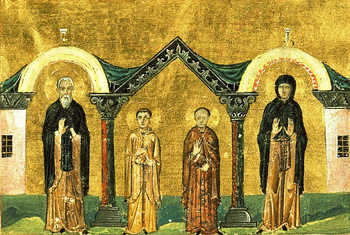 After a time at Beirut the young men went back to visit their parents. On their return to study, the ship on which they sailed was wrecked. The waves tossed the brothers ashore at different places.
After a time at Beirut the young men went back to visit their parents. On their return to study, the ship on which they sailed was wrecked. The waves tossed the brothers ashore at different places.
John came ashore in a unknown place, knocked on the door of a monastery and was received with hospitality. He remained in that monastery and became a fervent religious. Arcadius came ashore in Palestine and went to visit the Sepulcher of Christ to pray for his brother. There he met an old monk who convinced him to enter a monastery.
After a long time, Xenophon and Maria received the news that their sons had disappeared. They implored God all night to know what had happened. The next day they had a vision: Their two sons were close to Christ, John sitting on a throne with a scepter in his hand and a crown on his head and Arcadius with a diadem of stars and holding a Cross in his hand. They understood that the Cross was a figure of Christ in Jerusalem. So, they set out for that city.
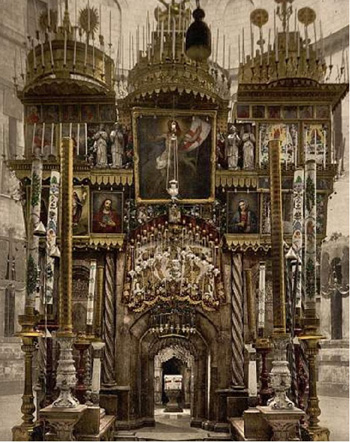 Arriving there, they sought long for their sons and finally met the same old man who had greeted Arcadius. He told them that he was the superior of a monastery and that the distraught couple would find what they were seeking, but first he wanted them to meet two of his exceptional disciples.
Arriving there, they sought long for their sons and finally met the same old man who had greeted Arcadius. He told them that he was the superior of a monastery and that the distraught couple would find what they were seeking, but first he wanted them to meet two of his exceptional disciples.
Xenophon and his wife accepted with pleasure. They gathered together at the Basilica of Calvary. Maria ordered a meal to be served to all monks. When all were at the table and the meal had begun, Xenophon could not contain himself any longer. Turning to the old man he said: "My father, what marvelous disciples you have! What modest and reserved behavior! I am moved just looking at them. I prayed to God that my sons would look like them."
Then, the superior asked one of the monks to tell his story.
Astonished, Xenophon and Maria learned that those two monks, completely transformed by prayer and fasting, were John and Arcadius who had disappeared so long time ago. Seeing this encounter as a lesson for both of them, Xenophon and Maria distributed their goods, went to separate monasteries and dedicated themselves to God.
Comments of Prof. Plinio:
A selection like this gives us some relief from the monstrous horrors of our days. Today we only hear about disasters, betrayals, fires, sicknesses and other such things. Here, no. Everything turns out well. The events occur like this: a virtuous and happy family, then a shipwreck and affliction, followed by an even happier outcome. Everything ends in smiles.
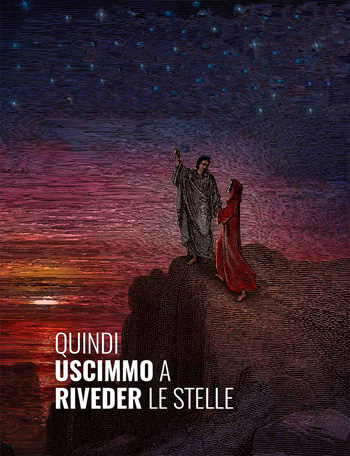 What a relief! After seeing Hell and returning to earth, Dante says in his Divine Comedy: "E
quindi uscimmo a riveder le stelle" (And thence we came forth to see the stars again), because in Hell there are no stars.
What a relief! After seeing Hell and returning to earth, Dante says in his Divine Comedy: "E
quindi uscimmo a riveder le stelle" (And thence we came forth to see the stars again), because in Hell there are no stars.
When I read texts like this, I have the desire to repeat his phrase. We can see the stars again.
You see that Xenophon and Maria were a couple that had the full blessing of Heaven and Earth. Both were from noble and wealthy families and live in Constantinople, the most important city in the world at that time. We recall the marvelous panorama of the Basilica of Hagias Sophia, the palaces, churches, baths, monuments and all the pomp of Constantinople.
The couple lived in that grand city in the love of God. They formed their sons very well. A moment would arrive when God would knock at the door of those noble souls, asking whether or not they would accept the Cross. The way the Cross was presented to them is easy to perceive.
First was a natural separation from the sons – they went to study in a famous school in Phoenicia; then, the shipwreck and their dispersion. With the apparent loss of their sons, the parents suffered great affliction. Did they die?
In a wonderful way the two sons ended at the same monastery under the direction of the same holy superior. There they progressed in holiness and transformed themselves without the knowledge of their family. Why? Either they were detaching themselves from their family and did not write to their parents or the letters they sent from Jerusalem did not arrive in Constantinople.
The fact is that the parents suffered more or less what the Holy Family suffered when Our Lady and St. Joseph discovered the Child Jesus was not with them on their return from Jerusalem.
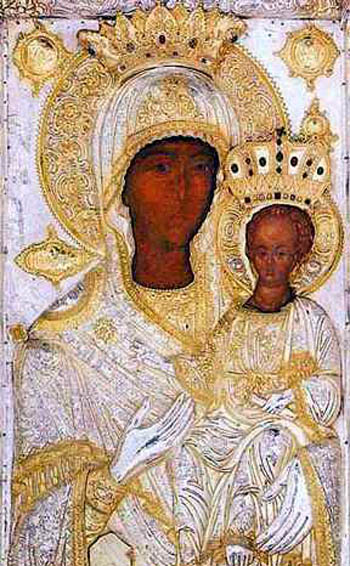 Xenophon and Maria were anguished, but they had faith. Learning about the shipwreck, they prayed all night asking for a sign to know where they could find their sons. They had a vision and saw one sitting in a throne and the other wearing a shining diadem with precious stones, both at the side of Our Lord Jesus Christ. These are symbols of a high spiritual perfection.
Xenophon and Maria were anguished, but they had faith. Learning about the shipwreck, they prayed all night asking for a sign to know where they could find their sons. They had a vision and saw one sitting in a throne and the other wearing a shining diadem with precious stones, both at the side of Our Lord Jesus Christ. These are symbols of a high spiritual perfection.
They went to Jerusalem and encountered the same old man who had first found one of their sons. He told the couple that he could help them find their sons but first he wanted them to meet two of his exemplary disciples. The old man had a certain measure of holy malice and the two parents a good measure of holy naïveté because they did not suspect that those disciples could be their sons.
The wife, St. Maria, ordered that a meal be prepared for all the monks and, at the table the couple became impressed by the sanctity of two of them. Then they learned that these two were their sons. The parents had not recognized them because they had changed so much due to their prayers and penances.
What a beautiful scene! Next, Divine Providence presented them with a new request: "Follow the path of your sons." So, the old couple separated to enter religious life and all four members of that family sanctified themselves.
Nothing could be more beautiful! This is a true happy close to a story where things end as they should.
There is only one thing that is missing in the selection. It does not give us the name of the old man, the superior of that monastery. He was the axis around which the solution for the admirable drama we are admiring here turned.
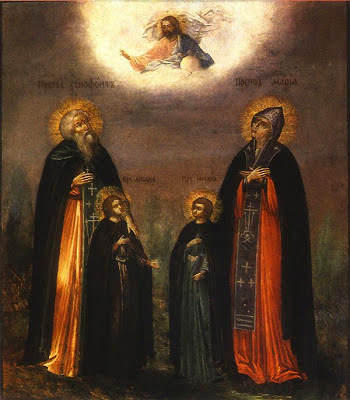 How such facts refresh the spirit! How light they make the soul feel and how they induce us to understand the attraction of virtue!
How such facts refresh the spirit! How light they make the soul feel and how they induce us to understand the attraction of virtue!
Based on this description you can imagine what you will feel when the Reign of Mary dawns. After the horrors of the Chastisement where we may see devils with all their hideousness, Our Lady will make a sign, her slaves will win the battle, and the devils will return to Hell. Finally, we will be able to see the stars again. We will feel a great relief and will understand how horrible and bad the world in which we lived was.
The question is how can we feel such a fascination for a world so bad even though when we are far from it we feel relieved? How this can be anything different from a spell of the Devil? It is the mystery of iniquity that attracts us until it is finally defeated by the Secret of Mary.


The Saint of the Day features highlights from the lives of saints based on comments made by the late Prof. Plinio Corrêa de Oliveira. Following the example of St. John Bosco who used to make similar talks for the boys of his College, each evening it was Prof. Plinio’s custom to make a short commentary on the lives of the next day’s saint in a meeting for youth in order to encourage them in the practice of virtue and love for the Catholic Church. TIA thought that its readers could profit from these valuable commentaries.
The texts of both the biographical data and the comments come from personal notes taken by Atila S. Guimarães from 1964 to 1995. Given the fact that the source is a personal notebook, it is possible that at times the biographic notes transcribed here will not rigorously follow the original text read by Prof. Plinio. The commentaries have also been adapted and translated for TIA’s site.
Xenophon and his wife Maria were a noble and very wealthy couple in Constantinople. They had two sons – Arcadius and John – whom they educated very well in the divine and profane sciences. To complete their education, the spouses sent their sons to Phoenicia to a famous school in the city of Beirut.

A noble and well-formed family
John came ashore in a unknown place, knocked on the door of a monastery and was received with hospitality. He remained in that monastery and became a fervent religious. Arcadius came ashore in Palestine and went to visit the Sepulcher of Christ to pray for his brother. There he met an old monk who convinced him to enter a monastery.
After a long time, Xenophon and Maria received the news that their sons had disappeared. They implored God all night to know what had happened. The next day they had a vision: Their two sons were close to Christ, John sitting on a throne with a scepter in his hand and a crown on his head and Arcadius with a diadem of stars and holding a Cross in his hand. They understood that the Cross was a figure of Christ in Jerusalem. So, they set out for that city.

The Holy Sepulcher in Jerusalem
Xenophon and his wife accepted with pleasure. They gathered together at the Basilica of Calvary. Maria ordered a meal to be served to all monks. When all were at the table and the meal had begun, Xenophon could not contain himself any longer. Turning to the old man he said: "My father, what marvelous disciples you have! What modest and reserved behavior! I am moved just looking at them. I prayed to God that my sons would look like them."
Then, the superior asked one of the monks to tell his story.
Astonished, Xenophon and Maria learned that those two monks, completely transformed by prayer and fasting, were John and Arcadius who had disappeared so long time ago. Seeing this encounter as a lesson for both of them, Xenophon and Maria distributed their goods, went to separate monasteries and dedicated themselves to God.
Comments of Prof. Plinio:
A selection like this gives us some relief from the monstrous horrors of our days. Today we only hear about disasters, betrayals, fires, sicknesses and other such things. Here, no. Everything turns out well. The events occur like this: a virtuous and happy family, then a shipwreck and affliction, followed by an even happier outcome. Everything ends in smiles.

And thence we came forth to see the stars again
When I read texts like this, I have the desire to repeat his phrase. We can see the stars again.
You see that Xenophon and Maria were a couple that had the full blessing of Heaven and Earth. Both were from noble and wealthy families and live in Constantinople, the most important city in the world at that time. We recall the marvelous panorama of the Basilica of Hagias Sophia, the palaces, churches, baths, monuments and all the pomp of Constantinople.
The couple lived in that grand city in the love of God. They formed their sons very well. A moment would arrive when God would knock at the door of those noble souls, asking whether or not they would accept the Cross. The way the Cross was presented to them is easy to perceive.
First was a natural separation from the sons – they went to study in a famous school in Phoenicia; then, the shipwreck and their dispersion. With the apparent loss of their sons, the parents suffered great affliction. Did they die?
In a wonderful way the two sons ended at the same monastery under the direction of the same holy superior. There they progressed in holiness and transformed themselves without the knowledge of their family. Why? Either they were detaching themselves from their family and did not write to their parents or the letters they sent from Jerusalem did not arrive in Constantinople.
The fact is that the parents suffered more or less what the Holy Family suffered when Our Lady and St. Joseph discovered the Child Jesus was not with them on their return from Jerusalem.

Icon of the Xenophon Monastery, called The Directress, or ‘She who points the way’
They went to Jerusalem and encountered the same old man who had first found one of their sons. He told the couple that he could help them find their sons but first he wanted them to meet two of his exemplary disciples. The old man had a certain measure of holy malice and the two parents a good measure of holy naïveté because they did not suspect that those disciples could be their sons.
The wife, St. Maria, ordered that a meal be prepared for all the monks and, at the table the couple became impressed by the sanctity of two of them. Then they learned that these two were their sons. The parents had not recognized them because they had changed so much due to their prayers and penances.
What a beautiful scene! Next, Divine Providence presented them with a new request: "Follow the path of your sons." So, the old couple separated to enter religious life and all four members of that family sanctified themselves.
Nothing could be more beautiful! This is a true happy close to a story where things end as they should.
There is only one thing that is missing in the selection. It does not give us the name of the old man, the superior of that monastery. He was the axis around which the solution for the admirable drama we are admiring here turned.

A family blessed on Earth and in Heaven
Based on this description you can imagine what you will feel when the Reign of Mary dawns. After the horrors of the Chastisement where we may see devils with all their hideousness, Our Lady will make a sign, her slaves will win the battle, and the devils will return to Hell. Finally, we will be able to see the stars again. We will feel a great relief and will understand how horrible and bad the world in which we lived was.
The question is how can we feel such a fascination for a world so bad even though when we are far from it we feel relieved? How this can be anything different from a spell of the Devil? It is the mystery of iniquity that attracts us until it is finally defeated by the Secret of Mary.

 | |
|
|
The texts of both the biographical data and the comments come from personal notes taken by Atila S. Guimarães from 1964 to 1995. Given the fact that the source is a personal notebook, it is possible that at times the biographic notes transcribed here will not rigorously follow the original text read by Prof. Plinio. The commentaries have also been adapted and translated for TIA’s site.


